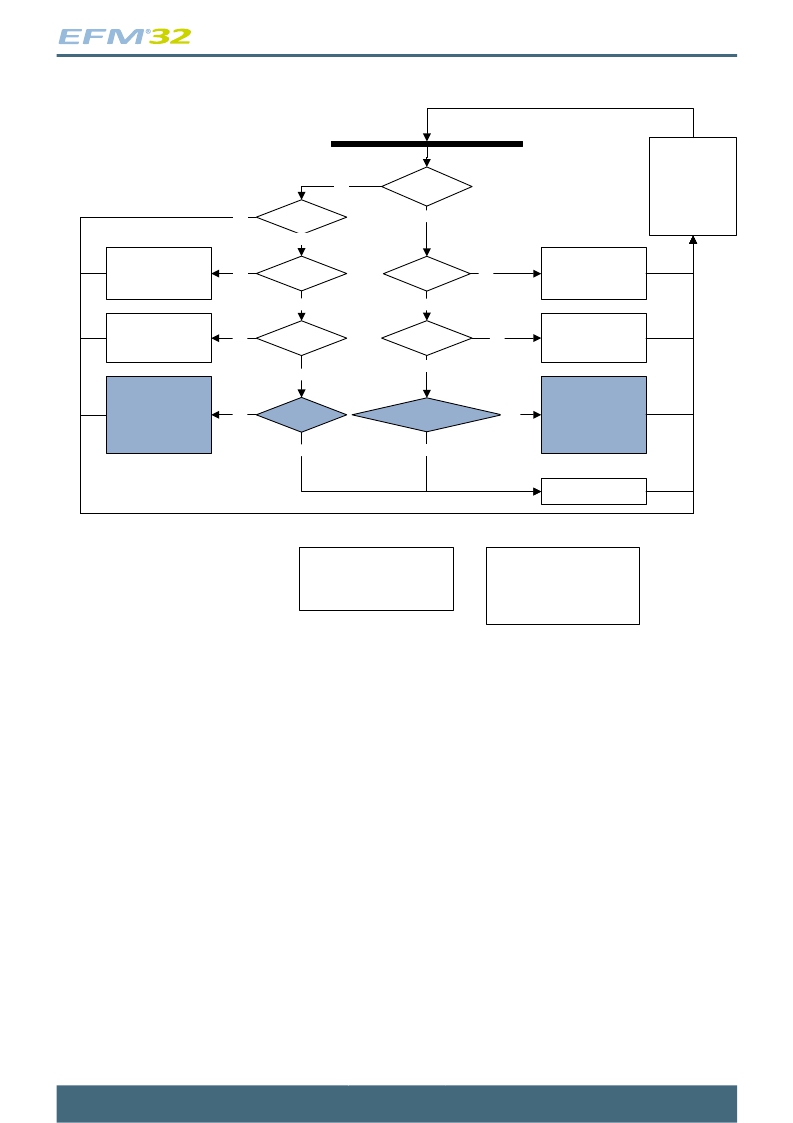- 您现在的位置:买卖IC网 > Sheet目录323 > EFM32G-DK3550 (Energy Micro)KIT DEVELOPMENT EFM32 GECKO
�� �
�
 �
�...the� world's� most� energy� friendly� microcontrollers�
�Figure� 21.4.� LETIMER� Buffered� Repeat� State� Machine�
�Wait� for� positive� clock� edge�
�If� (STOP)�
�RUNNING� =� 0�
�Else� if� (START)�
�NO�
�RUNNING�
�RUNNING� =� 1�
�End� if�
�NO�
�START�
�YES�
�START� =� 0�
�STOP� =� 0�
�YES�
�CNT� =� CNT� -� 1�
�NO�
�CNT� =� =� 0�
�CNT� =� =� 0�
�NO�
�CNT� =� CNT� -� 1�
�YES�
�YES�
�CNT� =� TOP*�
�CNT� =� TOP*�
�NO�
�REP0� =� =� 0�
�REP0� <� 2�
�NO�
�If� (!� START)�
�REP0� =� REP0� -� 1�
�CNT� =� TOP*� *�
�If� (BUFTOP)�
�YES�
�YES�
�CNT� =� TOP*�
�If� (BUFTOP)�
�COMP0� =� COMP1�
�NO�
�REP1� =� =� 0�
�!� REP1� USED� and� !� REP1� !� =� 0� YES�
�COMP0� =� COMP1�
�REP0� =� REP1�
�REP0� =� REP1�
�REP1� USED� =� 1�
�YES�
�NO�
�REP1� USED� =� 1�
�STOP� =� 1�
�REP0� =� 0�
�TOP*�
�If� (COMP0TOP)�
�TOP*� =� COMP0�
�Else�
�TOP*� =� 0xFFFF�
�TOP*� *�
�If� (!� COMP0TOP)�
�TOP*� *� =� 0xFFFF�
�Else� if� (BUFTOP)�
�TOP*� *� =� COMP1�
�Else�
�TOP*� *� =� COMP0�
�21.3.3.2.4� Double� Mode�
�The� Double� repeat� mode� works� much� like� the� one-shot� repeat� mode.� The� difference� is� that,� where� the�
�one-shot� mode� counts� as� long� as� LETIMERn_REP0� is� larger� than� 0,� the� double� mode� counts� as� long� as�
�either� LETIMERn_REP0� or� LETIMERn_REP1� is� larger� than� 0.� As� an� example,� say� LETIMERn_REP0�
�is� 3� and� LETIMERn_REP1� is� 10� when� the� timer� is� started.� If� no� further� interaction� is� done� with� the�
�timer,� LETIMERn_REP0� will� now� be� decremented� 3� times,� and� LETIMERn_REP1� will� be� decremented�
�10� times.� The� timer� counts� a� total� of� 10� times,� and� LETIMERn_REP0� is� 0� after� the� first� three� timer�
�underflows� and� stays� at� 0.� LETIMERn_REP0� and� LETIMERn_REP1� can� be� written� at� any� time.� After� a�
�write� to� either� of� these,� the� timer� is� guaranteed� to� underflow� at� least� the� written� number� of� times� if� the�
�timer� is� running.� Use� the� Double� repeat� mode� to� generate� output� on� both� the� LETIMER� outputs� at� the�
�same� time.� The� state� machine� for� this� repeat� mode� can� be� seen� in� Figure� 21.5� (p.� 293)� .�
�2011-04-12� -� d0001_Rev1.10�
�292�
�www.energymicro.com�
�发布紧急采购,3分钟左右您将得到回复。
相关PDF资料
EFM32GG-STK3700
KIT STARTER GIANT GECKO
EFM32LG-DK3650
KIT DEV EFM32 LEOPARD GECKO
EK-K7-KC705-CES-G-J
KINTEX-7 FPGA KC705 EVAL KIT
EK-S6-SP601-G
KIT EVAL SPARTAN 6 SP601
EK-S6-SP605-G
KIT EVAL SPARTAN 6 SP605
EK-V6-ML631-G-J
VIRTEX-6 HXT FPGA ML631 EVAL KIT
EK-V7-VC707-CES-G
VIRTEX-7 VC707 EVAL KIT
EK-Z7-ZC702-CES-G
ZYNQ-7000 EPP ZC702 EVAL KIT
相关代理商/技术参数
EFM32GG230F1024
功能描述:ARM微控制器 - MCU 1024KB FL 128KB RAM
RoHS:否 制造商:STMicroelectronics 核心:ARM Cortex M4F 处理器系列:STM32F373xx 数据总线宽度:32 bit 最大时钟频率:72 MHz 程序存储器大小:256 KB 数据 RAM 大小:32 KB 片上 ADC:Yes 工作电源电压:1.65 V to 3.6 V, 2 V to 3.6 V, 2.2 V to 3.6 V 工作温度范围:- 40 C to + 85 C 封装 / 箱体:LQFP-48 安装风格:SMD/SMT
EFM32GG230F1024G-E-QFN64R
功能描述:IC MCU 32BIT 1MB FLASH 64QFN 制造商:silicon labs 系列:Giant Gecko 包装:剪切带(CT) 零件状态:在售 核心处理器:ARM? Cortex?-M3 核心尺寸:32-位 速度:48MHz 连接性:I2C,IrDA,智能卡,SPI,UART/USART 外设:欠压检测/复位,DMA,POR,PWM,WDT I/O 数:56 程序存储容量:1MB(1M x 8) 程序存储器类型:闪存 EEPROM 容量:- RAM 容量:128K x 8 电压 - 电源(Vcc/Vdd):1.98 V ~ 3.8 V 数据转换器:A/D 8x12b,D/A 2x12b 振荡器类型:内部 工作温度:-40°C ~ 85°C(TA) 封装/外壳:64-VFQFN 裸露焊盘 供应商器件封装:64-QFN(9x9) 标准包装:1
EFM32GG230F1024-QFN64
制造商:Energy Micro AS 功能描述:GIANT GECKO MCU - Cut TR (SOS) 制造商:Energy Micro 功能描述:GIANT GECKO MCU 制造商:Energy Micro AS 功能描述:IC MCU 32BIT 1MB FLASH 64QFN
EFM32GG230F1024-QFN64T
制造商:Energy Micro AS 功能描述:GIANT GECKO MCU - Trays
EFM32GG230F1024-QFN64-T
制造商:Energy Micro AS 功能描述:IC MCU 32BIT 1MB FLASH 64QFN
EFM32-GG230F1024-SK
制造商:Energy Micro AS 功能描述:GIANT GECKO SAMPLE KIT - Bulk
EFM32GG230F1024-T
制造商:Energy Micro AS 功能描述:IC MCU 32BIT 1MB FLASH 64QFN
EFM32GG230F512
功能描述:ARM微控制器 - MCU 512KB FL 128KB RAM
RoHS:否 制造商:STMicroelectronics 核心:ARM Cortex M4F 处理器系列:STM32F373xx 数据总线宽度:32 bit 最大时钟频率:72 MHz 程序存储器大小:256 KB 数据 RAM 大小:32 KB 片上 ADC:Yes 工作电源电压:1.65 V to 3.6 V, 2 V to 3.6 V, 2.2 V to 3.6 V 工作温度范围:- 40 C to + 85 C 封装 / 箱体:LQFP-48 安装风格:SMD/SMT